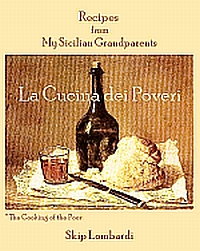Easter Pies
April 19th, 2014The local Amish community here in Sarasota have some wonderful pies on offer at this time of year.

Sign at a local Amish community restaurant
Copyright © 2014, Skip Lombardi
For a little insight into the way Italian-Americans make pies for Easter, have a look at our other blog Almost Italian.
You can find our recipe for Italian Easter Pie in our cookbook.
Buona Pasqua.
Palm Sunday in Sarasota
March 24th, 2013While tourists may bemoan their luck whenever they encounter ever-greater aberrations in Florida weather, our neighbors and their landscapers surely rejoiced in the thunderstorms of the past week. It’s not every day we can watch a cargo of Dypsis decaryi, Triangle Palms, off-loaded at a private residence. And it’s a blessing when mature palms can be installed without someone leaving a hose running for several hours.
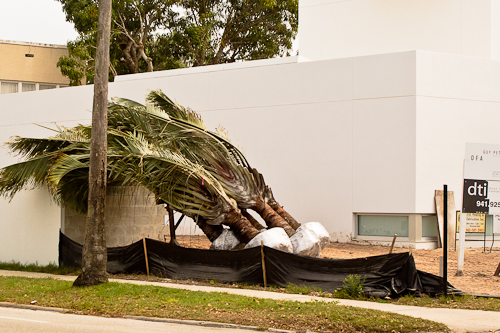
Copyright © 2013, Skip Lombardi
Along with the flowering Madagascar periwinkle, baobabs and the traveler’s, Bismark, and raffia palms, Dypsis decaryi are among the distinctive flora of Madagascar, where their habitats are seriously endangered by the island nation’s rampant deforestation. Thus, the Florida propagation of these striking exotics may help keep triangle palms from extinction.
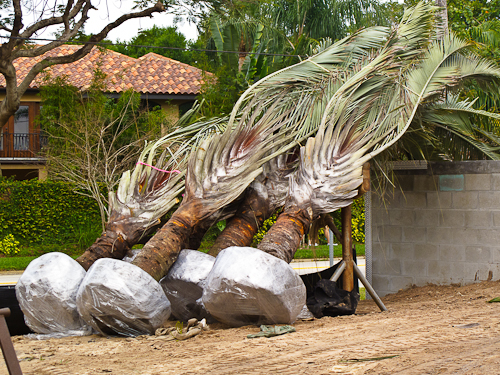
New to our ‘hood: A quintet of triangle palms awaits installation
Copyright © 2013, Skip Lombardi
We’re delighted to welcome these stately, silvery palms to the neighborhood and wish them their share of April showers!
Remembering Dave Brubeck
December 6th, 2012I‘ve been a Dave Brubeck fan for more than 50 years. Although I knew him only through his concerts and recordings, the news of his death yesterday struck me like the loss of a dear, old friend.
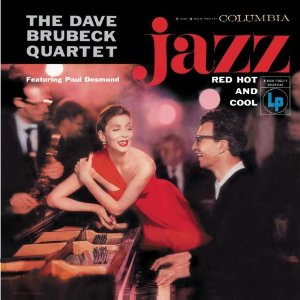
Photo Credit: Richard Avedon
I had an uncle—an ardent Jazz fan—who always seemed to have a new recording with him each time he visited. By the time I first heard Dave Brubeck in 1954 or ’55, I was already familiar with Charlie Parker, Dizzy Gillespie, Thelonious Monk, and the rest of the mostly black, New York-based, Hard Bop Jazz players. Even though I was only eight years old, I had, thanks to my uncle, developed a good basis for comparison of their different styles.
Dave Brubeck was considered to be a “West Coast” musician: a member of the “Cool School” of Jazz. And indeed, his music—particularly with Paul Desmond on alto saxophone—lacked the edge and drive that typified the “East Coast” be-bop of the day. But he and his quartet played with élan, facility, brilliant contrapuntal improvisation, and previously unheard harmonies.
My very first Dave Brubeck album was Jazz—Red Hot and Cool. Recorded live in New York City at a nightclub called Basin Street East, it captivated me.
The album included a number of tunes considered to be part of “The Great American Songbook.” Brought up-to-date with Brubeck’s unique sense of harmony and Paul Desmond’s wonderful lyricism, their arrangements swirled above the ambient nightclub clinking of cocktail glasses.

Photo Credit: Richard Avedon
Beyond the music, that album, whose cover featured Fifties supermodel Suzy Parker and Brubeck in a nightclub, eptomized for me the coolness of Jazz. Richard Avedon—one of the premier fashion photographers of the 20th century—clicked the shutter at the hungry i, then the hippest of San Francisco’s nightspots. What many Brubeck fans have forgotten is that both Helena Rubinstein cosmetics and Columbia Records shared the same Avedon photo for their joint promotion of both the record album and Jazz, a new lipstick and nail polish color launched by Mme.Rubenstein. That interesting cross-disciplinary use of art predated Mad Men by several decades.
But my most powerful recollection is a simple four-bar modulation in the last chorus of George Gershwin’s Love Walked In. As a child, I had yet to acquire the vocabulary to describe what I heard, but all these years and an undergraduate degree in music theory and harmony later, I can easily retrofit the experience.
With twelve bars left in the tune, the group spontaneously modulated, or changed, the key of the tune, up a whole step for four measures of the final phrase before returning to the original key for the last eight measures. I had never heard anything like it and couldn’t understand it, but I felt completely drawn into the music. I have been similarly amazed by Dave Brubeck countless times since.
While I mourn his passing, I can console myself with some wonderful musical discoveries and memories, and continue to enjoy the great legacy he’s left behind. Rest in peace.
Indian Potato Salad
July 3rd, 2011It’s Independence Day weekend 2011 and your fridge is full. It’s 118° F. in Phoenix, in the 90’s in the mid-Atlantic states, and at least that hot in Florida, where thunderstorms will probably trip the breaker on your air-conditioner at least once during the holiday. You’re having people come over for a cook-out or taking food to a picnic, and you’ve already run twice to the bait shop or CVS for extra ice…
Well, here’s one dish that you can make ahead and that you don’t have to chill—Potato Salad.
“Potato salad!? Are you kidding?” you say, remembering decades of horror stories of mayo-dressed salads that sickened entire First Communion parties or sent picnicking beachcombers to the ER.
Yes, potato salad. But one made without mayonnaise.
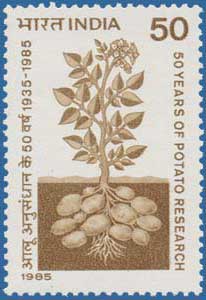
Today’s recipe takes a cue from a democracy as raucous as our own—India, where millions of vegetarians don’t eat eggs, but where cooks have devised myriad ways to elevate spuds to nirvana. Speaking of elevation, during the British Raj, gardeners developed local varieties for their hill-stations, their cooler summer residences. Sixteenth-century Portuguese traders first introduced the potato to India, but local laborers and English colonizers were the ones who struggled through droughts and monsoons to establish the crop in the Subcontinent. The named Indian cultivars of Solanum tuberosum are the stuff of Masterpiece Theatre: Magnum Bonum, Royal Kidney, Great Scot, and (our favorite) Craig’s Defiance. The Brits were homesick for their chips and shepherd’s pies, but what the spice masters of India learned to do with this New World tuber took things to another level. As a vehicle for other flavors, nothing beats the potato.
The potato also gives us an opportunity to champion a once-common American kitchen fixture that Indians continue to use with ease and flair. Though most American cooks don’t think of it as a hot-weather heat-saver, the pressure cooker is a miserly consumer of BTU’s and, thus, easy on the cook as well as the planet. (Of all the freedoms Americans enjoy and celebrate this weekend, for most of us, liberation from the power-grid is not one of them.) Because it cooks foods so much faster than a typical, lidded pot, we use our pressure cooker throughout the hot weather, to cut down on kitchen heat.
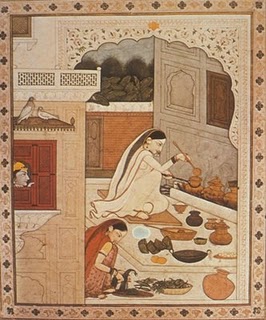
In particular, we love ours because it cooks whole potatoes in their skins so quickly and evenly. Just the energy saved in making your summertime potato salads could justify getting one. We promise you’ll find the pressure cooker to be, as one of us likes to say when he is feeling stentorian, “a trusted and valuable member of the culinary armamentarium.” The fact is that today’s pressure cookers are simple, efficient, and safe. (So, now you can relegate any urban legends about exploding pressure-cookers to the trash, right along with those bad mayonnaise memories.)
We offer our fear-free Indian Potato Salad. Whether you make it with—or without—a pressure cooker, do so at least an hour (and up to 12 hours) ahead of serving and remember that the flavors need a little time to meld. The salad is best at room temperature. You can refrigerate any leftovers, but we rarely have any.
Indian Potato Salad
Ingredients:
2 lbs. Waxy potatoes (we like Klondike Rose & Yukon Gold)
2 tsp. Whole mustard seeds (brown or yellow)
1 Tbs. Canola or other neutral oil
1/4 tsp. Salt
1/2 tsp. Hot red pepper flakes (optional)
4 Tbs. Vinegar (we like white wine or cider vinegar)
1/2 Cup Fresh cilantro or spearmint leaves, snipped with scissors
Freshly ground black pepper & salt, to taste.
Fresh lime wedges for garnish
Preparation:
To cook the potatoes:
Boil whole, scrubbed potatoes in their skins. Cook them until there is slight resistance when you try to pierce one to the center with the point of a sharp knife. Turn off the burner and leave them, covered in the hot water, until you are ready to use them. They will continue to cook.
If you are using a pressure cooker, follow the product directions for whole potatoes, or save even more energy and do it our way:
Fill the cooker half-way with water and unpeeled potatoes. Seal the cooker and bring it up to pressure on high heat. When it begins to hiss, reduce heat to medium and let the potatoes cook for 5 minutes. Turn the burner off and let the cooker sit, undisturbed, for at least 30 minutes. (Longer is OK. The residual heat will not overcook the potatoes.) This formula will cook two or three pounds of potatoes (even if they are mixed sizes) to perfection.
When you are ready to make the salad, release any remaining pressure from the pot and open the pressure cooker.
No matter how you have boiled your potatoes, the directions are now the same:
Drain the potatoes and put them cut them into large (1 1/2-inch / 4 cm) chunks, leaving the skins on the pieces. Put the pieces in a large mixing bowl and set aside.
Place the mustard seeds, oil, and 1/4 tsp. salt in a very small sauce pan with a lid. (Because you will have it on very high heat, do not use a pan with a synthetic non-stick coating, like Teflon. However, anodized aluminum is okay.)
Stir the seeds to coat them with the oil and cover the pan. Heat a small burner to high. With the lid securely on, place the pan on the hot burner and reduce the heat to medium. You will soon begin to hear the mustard seeds pop in the hot oil. When the popping stops (in about one minute or less), turn off the burner. Keeping the lid on, remove the pan from the heat and set aside to cool slightly for 1 minute. Keep it covered as a few more seeds may pop.
After a minute has passed, and if you are using the hot pepper flakes, stir them into the hot oil and seeds.
Have the vinegar at hand.
With a spoon, scrape all the toasted seeds and oil from the pan into the potatoes. Carefully pour the vinegar into the sauce pan to rinse out any remaining seeds and oil and then pour that over the potatoes. With a large spatula or wooden spoon, gently stir the potatoes until the seeds are evenly distributed.
If the potatoes are still hot, wait 10 minutes until they have cooled slightly and then add the snipped cilantro or mint and freshly ground black pepper. Stir to distribute evenly. Taste for salt. You may add a little more vinegar, to taste; the potatoes will absorb it.
Serves 4 – 6, depending on your other side dishes
Feel free to vary the fresh herbs. For Indians, neither basil nor tarragon is a salad herb, but either is lovely with mustard seeds. To amplify the Indian aspect, we like to add freshly grated ginger and the rind of a grated lime. If you need more fireworks, judiciously add a few chopped chilies (fresh, pickled, or dried).
As our founding fathers demonstrated, the Fourth of July is an auspicious date for grand experiments!


